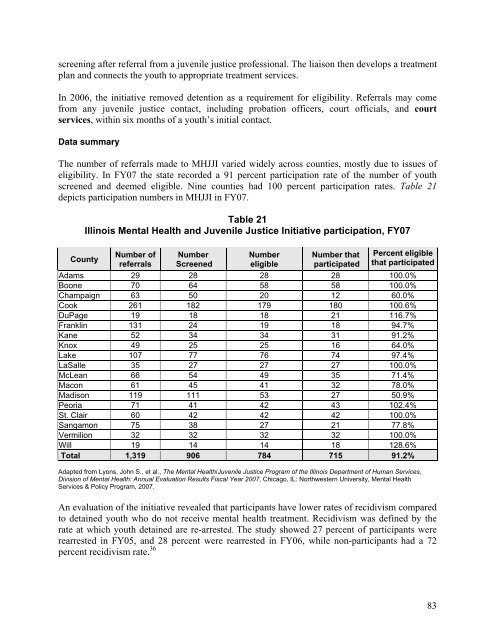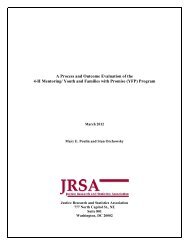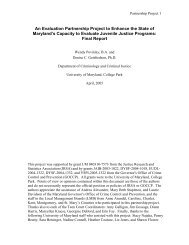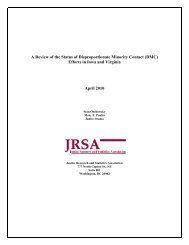Juvenile Justice System and Risk Factor Data - Illinois Criminal ...
Juvenile Justice System and Risk Factor Data - Illinois Criminal ...
Juvenile Justice System and Risk Factor Data - Illinois Criminal ...
Create successful ePaper yourself
Turn your PDF publications into a flip-book with our unique Google optimized e-Paper software.
screening after referral from a juvenile justice professional. The liaison then develops a treatment<br />
plan <strong>and</strong> connects the youth to appropriate treatment services.<br />
In 2006, the initiative removed detention as a requirement for eligibility. Referrals may come<br />
from any juvenile justice contact, including probation officers, court officials, <strong>and</strong> court<br />
services, within six months of a youth’s initial contact.<br />
<strong>Data</strong> summary<br />
The number of referrals made to MHJJI varied widely across counties, mostly due to issues of<br />
eligibility. In FY07 the state recorded a 91 percent participation rate of the number of youth<br />
screened <strong>and</strong> deemed eligible. Nine counties had 100 percent participation rates. Table 21<br />
depicts participation numbers in MHJJI in FY07.<br />
Table 21<br />
<strong>Illinois</strong> Mental Health <strong>and</strong> <strong>Juvenile</strong> <strong>Justice</strong> Initiative participation, FY07<br />
County<br />
Number of Number<br />
Number Number that<br />
Percent eligible<br />
referrals Screened eligible participated that participated<br />
Adams 29 28 28 28 100.0%<br />
Boone 70 64 58 58 100.0%<br />
Champaign 63 50 20 12 60.0%<br />
Cook 261 182 179 180 100.6%<br />
DuPage 19 18 18 21 116.7%<br />
Franklin 131 24 19 18 94.7%<br />
Kane 52 34 34 31 91.2%<br />
Knox 49 25 25 16 64.0%<br />
Lake 107 77 76<br />
74 97.4%<br />
LaSalle 35 27 27 27 100.0%<br />
McLean 66 54 49 35 71.4%<br />
Macon 61 45 41 32 78.0%<br />
Madison 119 111 53 27 50.9%<br />
Peoria 71 41 42 43 102.4%<br />
St. Clair 60 42 42 42 100.0%<br />
Sangamon 75 38 27 21 77.8%<br />
Vermilion 32 32 32 32 100.0%<br />
Will 19 14 14 18 128.6%<br />
Total 1,319 906 784 715 91.2%<br />
Adapted from Lyons, John S., et al., The Mental Health/<strong>Juvenile</strong> <strong>Justice</strong> Program of the <strong>Illinois</strong> Department of Human Services,<br />
Division of Mental Health: Annual Evaluation Results Fiscal Year 2007, Chicago, IL: Northwestern University, Mental Health<br />
Services & Policy Program, 2007.<br />
An evaluation of the initiative revealed that participants have lower rates of recidivism compared<br />
to detained youth who do not receive mental health treatment. Recidivism was defined by the<br />
rate at which youth detained are re-arrested. The study showed 27 percent of participants were<br />
rearrested in FY05, <strong>and</strong> 28 percent were rearrested in FY06, while non-participants had a 72<br />
percent recidivism rate. 36 83

















